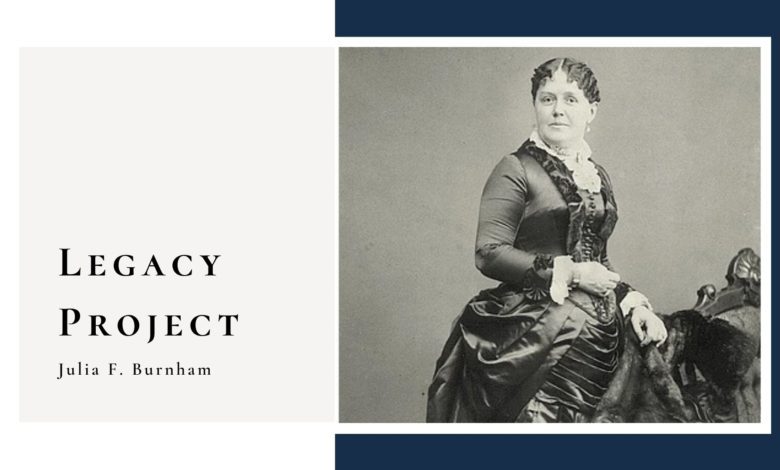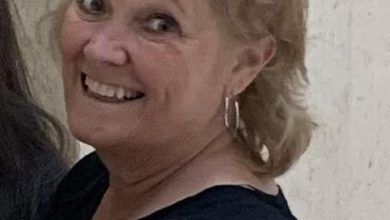East Central Illinois Legacy Project: Julia F. Burnham

EDITOR’S NOTE: In order to understand living conditions and social movements of past centuries, the Mahomet Daily will feature residents of East Central Illinois who have done the little things in their lives to make a difference in moving equality for all forward. This project is in partnership with the Museum of the Grand Prairie, which is collecting stories for their This Legacy is Yours project. To learn
more visit http://www.museumofthegrandprairie.org/exhibits.html.
In the late 19th century, Julia Burnham can be seen wearing a corset and a steel-hooped cage crinoline to hold the skirt of her dress.
Her dress shows her privilege along with her limitations.
The educated woman from New York was blessed with many opportunities that were not afforded to other women of her time. While Burnham had the means to devote her life to helping those in need, many women during the same time period spent their lives tending to tasks within the home.
The maiden Julia Davidson, though, married Mr. Albert C. Burnham, a lawyer, banker and philanthropist in Champaign, Ill., while in Philadelphia in 1866. Julia gave birth to five children. Three of these children died in infancy while two, Egbert and Mary (Harris) carried on their parents’ legacy.
Just a little over 200 years ago, married women lost their identity, taking on and being referenced by their husband’s names. Married women were, in fact, property of their husband.
Today, records show the movements Julia made during her 54 years. But at that time, when women were accounted for in public records by “Mrs.” with their husband’s first and last name instead of their own, Julia’s ideas and accomplishments came with the credit of her husband.
The same holds true for the members of the Woman’s Social and Political Science Club of Champaign County. Founders Melissa Harris and Elgin Ray attended the inaugural meeting of the National Council of Women in 1888 where Francis Willard was elected President of the new organization while Susan B. Anthony was elected Vice-President.
Harris came back to Champaign with ideas on how to advance women’s work in education, philanthropy, reform, and social culture as the women’s suffrage movement began to take shape.
Julia joined Melissa’s group, which began just studying the formation of the U.S. Constitution alongside the laws of Illinois as they pertain to women and children with 35 other women in the Champaign area. They were particularly interested in land ownership.
By 1893, the club, now named The Social Science Club of Champaign, had turned their sights to tangible service projects within the community.
The roles women undertook during the Civil War helped them to see opportunity in society as the nation rebuilt.
Women began to challenge the Victorian principles where women were to remain in a passive role within the family and society. Opportunities for women to receive a secondary education grew while single women were able to obtain jobs in factories and retail establishments. Still, throughout the nineteenth century, 95-percent of married women remained “at home.”
With means to provide for her family, Julia could have opted to stay at home with her children. But, known as a “physically robust” woman, serving the Champaign community was something that Julia was known for.
Her obituary in the Champaign County News (October, 1884) reads, “She was one of the most widely-known women in this part of the state. Locally she was a model of disinterested benevolence and Christian charity. In all charitable matters, she was invariably consulted and her gifts for these purposes were freely and liberally given. She was a member of the local visiting committee of the State Board of Public Charities and took great care of the county poor house, the jail and city prisons, the poor and unfortunate being always the special objects of her solicitude.”
Just a year before her death, at a meeting of The Social Science Club, Julia proposed that the organization explore the possibility of establishing a hospital in Champaign. A month later, the idea became a reality when the club voted to undertake the project, and Julia’s husband, A.C., made a $10,000 donation to fund the project.
The donation was made in his wife’s name, according to The Champaign Daily Gazette (Jan. 1894).
A.C. also placed some conditions on the funding:
- The hospital must be located within the City of Champaign and controlled by a board of trustees, of which Julia would remain a lifetime member;
- The hospital would be available to all residents of Champaign County;
- The money should be used for the erection of the building.
The hospital was also to be named the Julia F. Barnham Hospital.
By March, after Elgin Ray, Jessie Davidson and Melissa Harris resigned from the club, and W.L. Pillsbury, Ross Mattis, and University Professor Nathan C. Ricker became Board of Supervisors Ex-officio members, the block surrounded by Springfield Avenue, Third Street, Stoughton Street, and Fourth Street were purchased with a $1,000 donation from J.C. Kirkpatrick and an increased gift of $15,000 from A.C. Burnham.
Another donation increase to $19,000 allowed construction of the hospital to begin in July 1884. On August 23, 1894, the cornerstone with the hospital’s motto, “With Good Will Doing Service” was laid.
The vision for Burnham Hospital was not only a place for people to tend to the sick and dying, but to help transform medical institutions into a place “to live and get well.”
This movement in the mid-to-late 19th century focused on local medical facilities where residents could form relationships with medical professionals throughout their lifetime rather than doctors providing home care as emergencies arose.
According to the AMA Journal of Ethics, these hospitals were designed to not just care for the elite, but to be a charity, providing free or low-cost care to the sick poor, admitting patients of any creed, race, or ethnicity.
On the cusp of developing what Americans know as medical care today, the hospital was designed with wards, children’s services, offices, nurse’s rooms, a dining room, a laundry facility and a separate space for patients with contagious diseases.
Days before leaving for New York in October, a friend noted that Julia looked pale. According to her obituary, Julia replied that she felt fine, other than being tired and fatigued.
As the president of the hospital association, it was noted that the fatigue may have been a result of months of planning for the hospital design and mission. Julia died of paralysis on her trip to New York, never to see the hospital she proposed functioning.
But it did function in the Champaign community for a century.
The state-of-the-art “Romanesque structure” opened in 1895 with room for 25 patients, four nurses and eight doctors.
Prior to the 1920’s, resources to carry out the day-to-day operation of medical facilities were limited. Many doctors donated their time and knowledge while nursing staff received minimal pay.
In the first year, 136 patients were served.
After the building was providing service to the community, the board took on another vision of The Social Science Club in 1902: a nursing school.
According to champaignhistory.com, The History of Burnham Hospital state that the nursing school would “provide trained nurses for the care of all the sick increases the expense of the hospital but since skilled nursing constitutes the principal advantage to be gained by going to the hospital and is the thing the patients pay for we feel that in thus planning we are maintaining a correct principle.”
A nurse’s home was erected in 1900 with the first students arriving to train in 12-hour days, seven days a week in 1904.
Over 800 nurses graduated from the Julia F. Burnham School of Nursing.
Burnham’s daughter, Mary, carried on her parents philanthropic work, offering a $12,000 loan to expand the men’s and women’s wings of the hospital, and to add a maternity wing, a surgery room, a doctor’s dressing room and to expand the isolation ward.
In her last gift to the hospital in 1920, Mary donated $75,000 for the expansion of the hospital and another $25,000 to the hospital’s endowment fund.
The hospital board said, “”With a heart pulsating for the welfare and happiness of others, and with the generosity in keeping with her means, she sought out opportunities for doing good. The great work for public welfare, which was so generously started by her father, she made her particular concern, and in the years to come the lives of men, women, and children will be made easier and more secure because of her.”
Mary passed away a year later.
With the gift, and $40,000 of bonds, the board doubled the hospital capacity to 80, enlarged the operating rooms, purchased new lighting and equipment and added a nursery.
Americans began to see that funded medical institutions that focused on advancements of knowledge, cleanliness and training could bring hope in illnesses that were once incurable.
This hope led to an overwhelming response to a special election held on July 16, 1924 when the City of Champaign voted to acquire and maintain the Julia F. Burnham Hospital. It was renamed Burnham City Hospital.
The hospital continued to function, not without renovations and additions, until 1992. By the 1980’s the hospital was costing Champaign taxpayers $1,000,000 a year, according to former Mayor Dan McCollum. The hospital was sold to Mercy Hospital in 1989.
In the place of the Julia F. Burnham Hospital today is a County Market and apartment building. But the memories, the jobs, the life that the hospital created are part of the fabric of the Champaign-Urbana community today.
A memorial at the site reads:
Here stands a tribute to a family’s pledge to the health and well-being of its community. The Burnham family held a deep commitment to the healthcare needs of those in its community, and Albert C. Burnham stepped forward to become the principal contributor to a hospital building project. His wife, Julia F. Burnham was an active promoter of the project through her involvement with the Champaign Social Science Club, which organized and successfully completed the funding campaign. As a result, the doors of the hospital were opened in 1895. Sadly, Julia passed away shortly before the work was completed. In tribute to the Burnham family’s financial and volunteer support the hospital was named the Julia F. Burnham Hospital.
In keeping with this commitment of caring, Albert and Julia’s granddaughter, Julia Harris Dodds, devoted much of her life to the hospital, serving on the Board of Directors for almost 40 years. Her devotion to the hospital and its school of nursing was unmatched. Her support of the faculty and students helped develop both the hospital and the school to a level of prestigious recognition. Through her efforts, countless lives in our community were touched.”
Sources
America’s Essential Hospitals. 2021. Emergence of Public Hospitals: 1860 –1930 – America’s Essential Hospitals. [online] Available at: <https://essentialhospitals.org/about-americas-essential-hospitals/history-of-public-hospitals-in-the-united-states/emergence-of-public-hospitals-1860-1930/> [Accessed 2 March 2021].
Blakeman, T., 2021. Julia F. Burnham Hospital. [online] Champaignhistory.com. Available at: <https://www.champaignhistory.com/post/burnham> [Accessed 2 March 2021].
Hartman, D., 2021. Lives of Women. [online] Conner Prairie. Available at: <https://www.connerprairie.org/educate/indiana-history/lives-of-women/> [Accessed 2 March 2021].
Kisacky, J., 2021. An Architectural History of US Community Hospitals. [online] Journal of Ethics | American Medical Association. Available at: <https://journalofethics.ama-assn.org/article/architectural-history-us-community-hospitals/2019-03> [Accessed 2 March 2021].
Newspapers.com. 2021. 6 Jan 1894, 1 – The Champaign Daily Gazette at Newspapers.com. [online] Available at: <https://www.newspapers.com/image/668226400/?terms=julia%20burnham&match=1> [Accessed 2 March 2021].
Quirke, T., 2021. History of the Champaign Social Science Club. [online] Usd116.org. Available at: <http://www.usd116.org/ProfDev/AHTC/lessons/ChristensenFel07/JuliaBurnham/ssclub.pdf> [Accessed 2 March 2021].
Usd116.org. 2021. Death of Mrs. Julia F. Burnham. [online] Available at: <http://www.usd116.org/ProfDev/AHTC/lessons/ChristensenFel07/JuliaBurnham/burnhamobit.JPG> [Accessed 2 March 2021].




